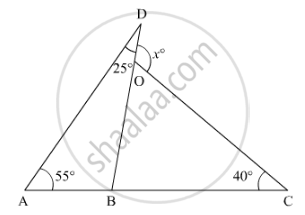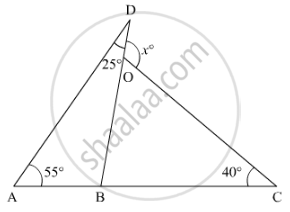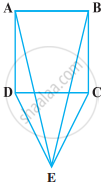Advertisements
Advertisements
Question
In the given figure, the value of x is ______.

Options
65°
80°
95°
120°
Solution
In the given figure, the value of x is 120°.
Explanation:
In the given figure, we need to find the value of x

Here, according to the angle sum property of the triangle
In ΔABD
∠BAD + ∠DBA + ∠ADB = 180°
55° + ∠DBA + 25° = 180°
80 + ∠DBA = 180°
∠DBA = 180° - 80°
∠DBA = 100°
∠DBA = 100°
Also, ABC is a straight line. So, using the property, “angles forming a linear pair are supplementary”, we get,
∠DBA + ∠DBC = 180°
100 + ∠DBC = 180°
∠DBC = 180° - 100°
∠DBC = 80°
Further, using the property, “exterior angle of a triangle is equal to the sum of two opposite interior angles”, we get
ext. ∠DOC + ∠OBC + ∠OCB
x = 80°+ 40°
x = 120°
Thus, x = 120°
APPEARS IN
RELATED QUESTIONS
BD and CE are bisectors of ∠B and ∠C of an isosceles ΔABC with AB = AC. Prove that BD = CE.
Which of the following statements are true (T) and which are false (F):
If the bisector of the vertical angle of a triangle bisects the base, then the triangle may be isosceles.
Which of the following statements are true (T) and which are false (F)?
Of all the line segments that can be drawn from a point to a line not containing it, the perpendicular line segment is the shortest one.
Fill in the blank to make the following statement true.
If two angles of a triangle are unequal, then the smaller angle has the........ side opposite to it.
Fill in the blank to make the following statement true.
If two sides of a triangle are unequal, then the larger side has .... angle opposite to it.
If the angles of a triangle are in the ratio 2 : 1 : 3, then find the measure of smallest angle.
It is given that ∆ABC ≅ ∆FDE and AB = 5 cm, ∠B = 40° and ∠A = 80°. Then which of the following is true?
In ∆PQR, if ∠R > ∠Q, then ______.
M is a point on side BC of a triangle ABC such that AM is the bisector of ∠BAC. Is it true to say that perimeter of the triangle is greater than 2 AM? Give reason for your answer.
CDE is an equilateral triangle formed on a side CD of a square ABCD (Figure). Show that ∆ADE ≅ ∆BCE.

